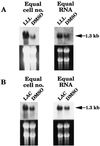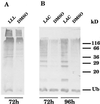Proteasome inhibitors prevent tracheary element differentiation in zinnia mesophyll cell cultures
- PMID: 9765527
- PMCID: PMC34817
- DOI: 10.1104/pp.118.2.419
Proteasome inhibitors prevent tracheary element differentiation in zinnia mesophyll cell cultures
Abstract
To determine whether proteasome activity is required for tracheary element (TE) differentiation, the proteasome inhibitors clasto-lactacystin beta-lactone and carbobenzoxy-leucinyl-leucinyl-leucinal (LLL) were used in a zinnia (Zinnia elegans) mesophyll cell culture system. The addition of proteasome inhibitors at the time of culture initiation prevented differentiation otherwise detectable at 96 h. Inhibition of the proteasome at 48 h, after cellular commitment to differentiation, did not alter the final percentage of TEs compared with controls. However, proteasome inhibition at 48 h delayed the differentiation process by approximately 24 h, as indicated by examination of both morphological markers and the expression of putative autolytic proteases. These results indicate that proteasome function is required both for induction of TE differentiation and for progression of the TE program in committed cells. Treatment at 48 h with LLL but not clasto-lactacystin beta-lactone resulted in partial uncoupling of autolysis from differentiation. Results from gel analysis of protease activity suggested that the observed incomplete autolysis was due to the ability of LLL to inhibit TE cysteine proteases.
Figures






References
LinkOut - more resources
Full Text Sources

